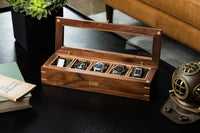If you’re new to the watch collecting space, you likely have little context for important measurement points such as diameter, lug-to-lug, case thickness, and more. People’s wrist circumference and personal preferences are different, and watches aren’t a one-size-fits-all product — so let’s see if we can’t help you make sense of some of the madness that is watch sizing.
Let's get straight into it, shall we?
Diameter:

When we speak about diameter, we’re talking about the width of the watch from the left flank of the case to the right flank of the case. This generally doesn’t include the crown unless specifically mentioned — or the bezel, should it overhang the case.
In the early part of the 20th century, smaller diameters such as 31 to 33mm were much more common, while 36mm was considered large, and 40mm was positively enormous. (In special cases, such as with certain pilot’s watches during WWII, even larger diameters were realized.) The 1990s saw gargantuan timepieces enter the zeitgeist once brands such Panerai became a public-facing brand — think 47mm giants — and that hysteria influenced the rest of the industry for some time, through the early 2000s.
These days, 40mm is considered to be sort of the sweet spot for sports watches such as divers — and even some dress watches — while sizes in general are trending back down to sub-40mm. Dress watches are generally not quite as wide as sport watches, though there are of course exceptions to this rule, such as 40mm Patrimony timepieces from Vacheron Constantin. Chronographs larger than 40mm are frequently encountered, while divers typically live in the 39-42mm range. Rectangular dress watches, such as the Tank from Cartier, are often much less wide given their particular design.
One should, in as many cases as possible, try on a potential purchase before buying to make sure that the case diameter is both physically comfortable on-wrist and aesthetically in line with your use case. Most men have a wrist somewhere in the (roughly) 6-8 inch range in circumference, and this number will absolutely influence one’s choice of timepiece.
Case Depth/Thickness:

This is the measurement of the case from the case back (the part that sits against one’s wrist) to the top of the watch crystal, and is alternatively referred to as “case depth” or “thickness.” This number will be much thinner for hand-wound (or even automatic) dress watches, and typically much thicker for automatic sports watches such as divers, GMTs, and especially chronographs. An ultra-thin dress watch might measure just a handful of millimeters thick, while a particularly chunky GMT, for example, might be closer to 15mm. Some specialized sport watches are 18mm thick or more!
Keep in mind that if you’re wearing a thick watch with a short-sleeved shirt, this isn’t much of a concern. But the moment you put on a dress shirt or a suit or tuxedo, you’d ideally like the watch to disappear under your cuff. Also, a thicker watch more easily hangs up on — well — stuff in general.
However, a thicker case often means better water resistance, so also keep this in mind. (We realize this is a lot of information to store in your noggin, so try to remember this: the dressier the watch, the thinner it often is.)
Lug to Lug:

In this case — pun intended — we’re talking about the case length from the bottom of the bottom lugs to the top of the top lugs. This is actually the measurement that is perhaps most important when considering a new watch purchase, as it determines whether the watch will potentially overhang your wrist bones! (If it does, this can be highly uncomfortable.) A smaller watch with particularly long lugs, such as certain NOMOS models, can be made to look (and wear) much larger, while conversely, a wider watch with shorter lugs might actually wear quite well on even a smaller wrist.
These measurements vary widely and aren’t quite as standardized as case width — all the more reason to physically try on a potential purchase before entering your credit card information.
Lug Width:

This is the distance between the lugs — the diameter of the strap where it meets the watch, essentially. It doesn’t have a huge influence on the wearability of the watch. Really, the larger the watch, the larger the lug width, generally. Here are some common widths:
-Older, smaller dress watches: 14-16mm
-Many vintage, round field and dress watches: 18mm
-34mm vintage Rolex: 19mm
-Many modern 40mm watches: 20mm
-Some Panerai and 40mm+, larger modern watches: 22mm
In Conclusion:
At the end of the day, the most important thing to take away from all this information is that watches will wear differently to everyone, and while measurement data is helpful to get a general sense of how it might fit on you - it’s always best to try on as many watches as possible to get a sense of how they wear and make you feel. Only then will you get a sense of what’s most comfortable and attractive to you.
Remember, Analog:Shift offers a ten-day inspection period for all watch purchases so you can try them on at home and make sure they work for you!












